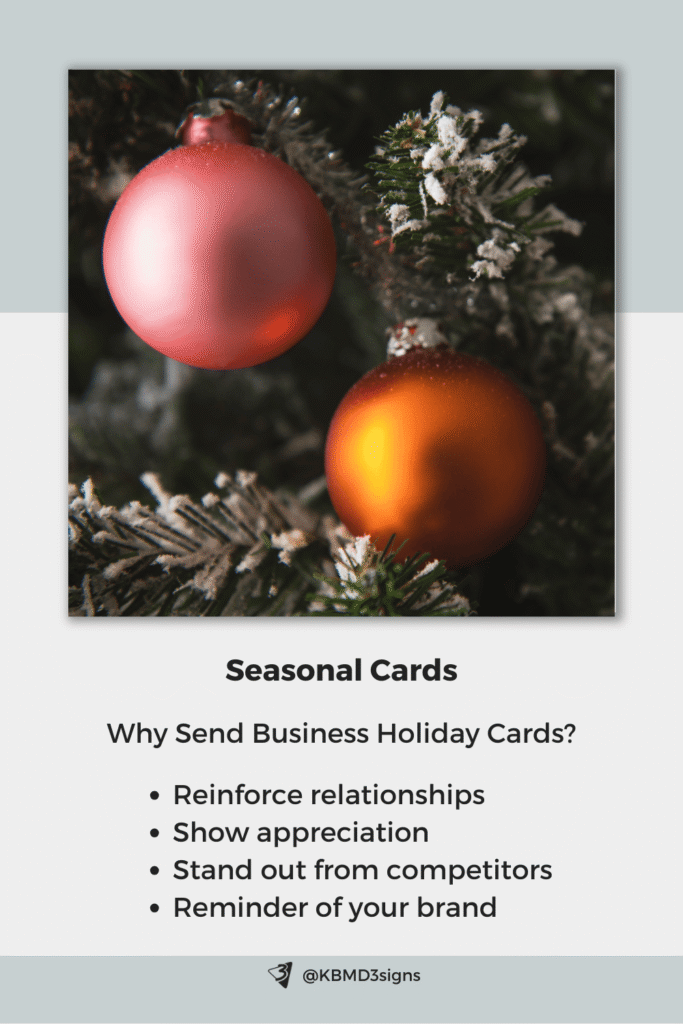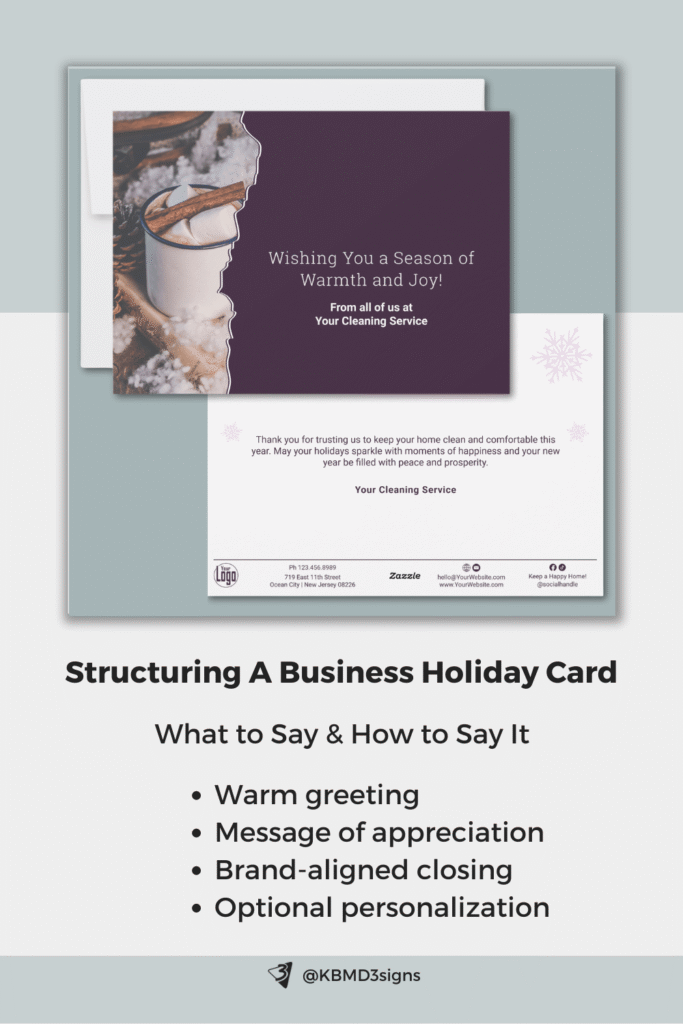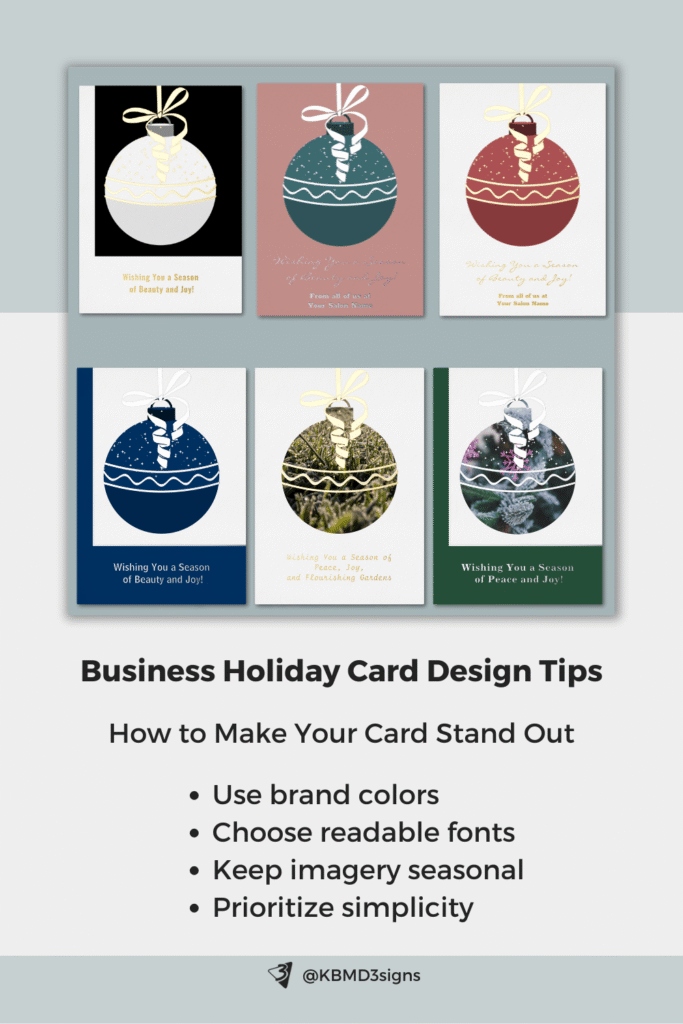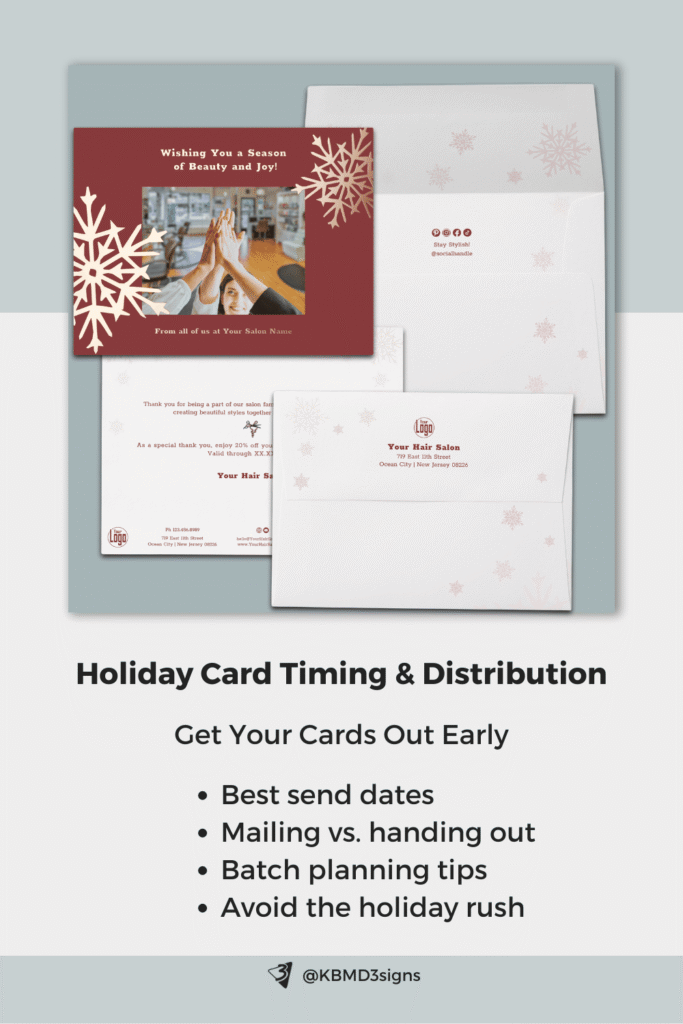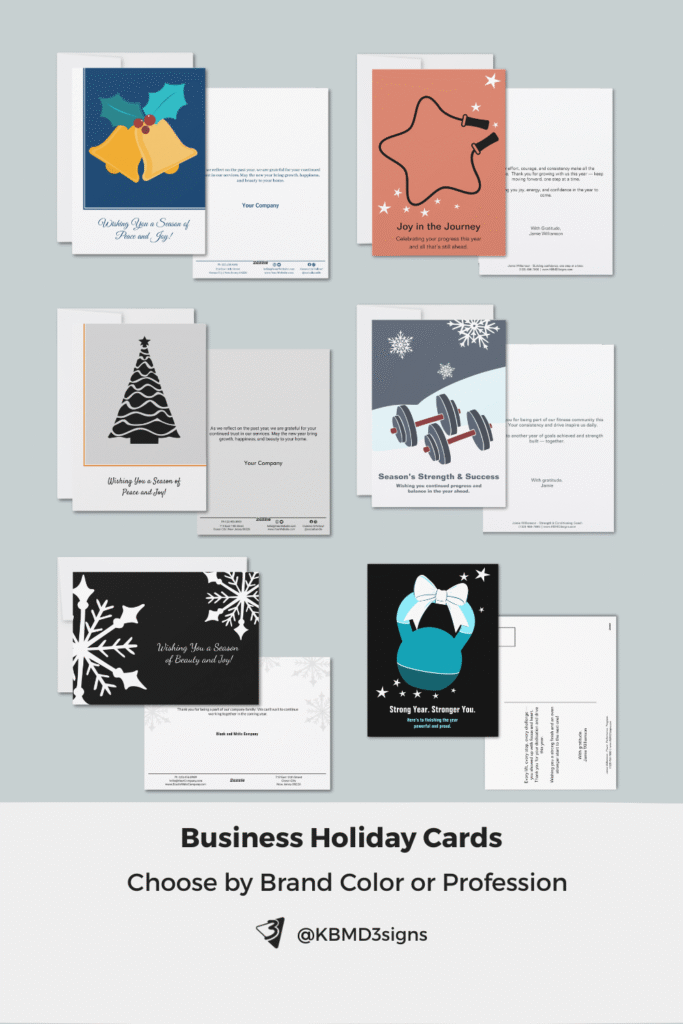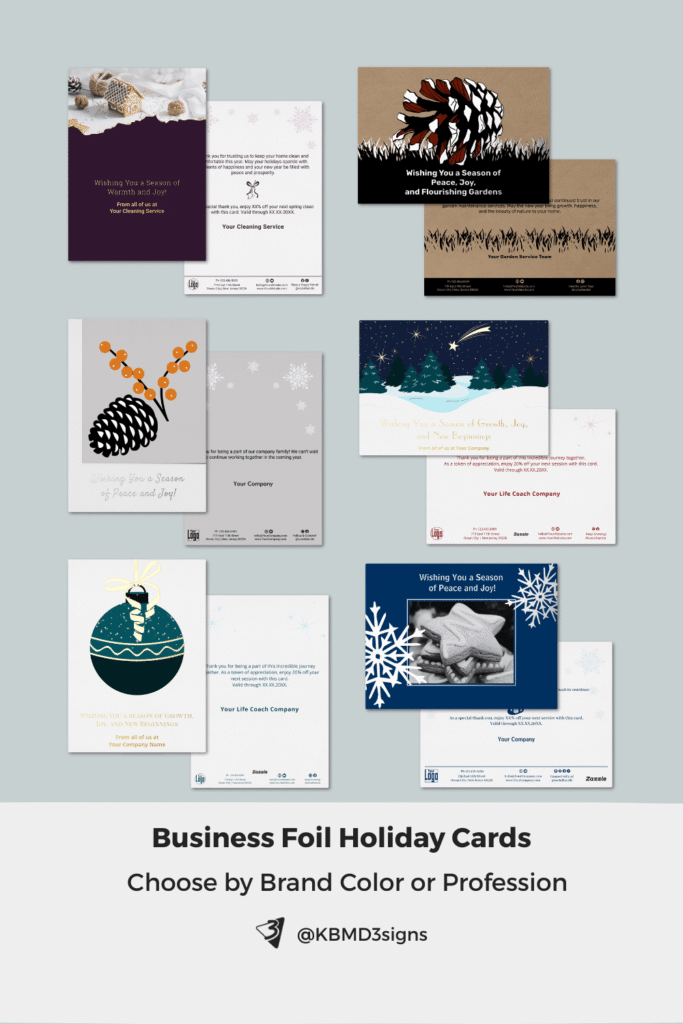Business Holiday Cards offer a unique opportunity to strengthen relationships with customers, partners and employees, while showcasing the personal touch that small businesses are known for. In the age of digital marketing, it is easy for small businesses to overlook the importance of traditional, offline marketing tools like these.
Thoughtfully designed holiday cards can build loyalty, show appreciation and serve as a subtle yet effective marketing tool. Here’s how to structure, design and make the most of holiday cards for your small business.
Article Content:
- Why Send Business Holiday Cards?
- Structuring Your Business Holiday Cards
- Design Tips: Making the Most of Your Holiday Cards
- Timing and Distribution: Get the Cards Out Early
- Custom Business Holiday Cards by KBM D3signs
- Are business holiday cards generally referring to Christmas?
- What holidays do companies potentially send cards for?
- Frequently Asked Questions about Business Holiday Cards
1. Why Send Business Holiday Cards?
Holiday cards offer a personal and meaningful way to connect with clients, far beyond the impersonal nature of many digital communications. They can:
- Reinforce relationships with clients, vendors, and partners.
- Show appreciation for your customers’ business over the past year.
- Stand out from competitors who may rely only on online communications.
- Serve as a reminder of your brand as the new year approaches.
These cards are not just a holiday gesture, they are an offline marketing tool that can be just as impactful, if not more, than email campaigns or social media posts.
2. Structuring Your Business Holiday Cards
Holiday cards are most effective when they strike the right balance between personal warmth and professional clarity. Although the overall structure remains similar across industries, adding a personal touch, such as a handwritten signature, a tailored message, or brand-specific elements, helps your card feel sincere rather than formulaic.
Below are examples of how different small businesses can structure their message:
- Coaches & Consultants: Add a line of encouragement or progress acknowledgment before the holiday wishes.
- Service Providers (cleaners, hairstylists, maintenance professionals): Include a brief thank-you for trust and ongoing loyalty.
- Product-based businesses: Reinforce appreciation for support and introduce a subtle “looking forward to serving you next year” note.
- Wellness and fitness professionals: Combine holiday wishes with motivation and positivity for the year ahead.
Thoughtful personalization, whether in tone, content, or design, helps your card feel uniquely yours while still maintaining a polished, business-appropriate structure.
Here’s a simple breakdown of what to include:
2-1. Personalized Greeting
Address each recipient by name and include a greeting that aligns with the holiday season. If possible, handwrite this portion of the card for an added personal touch, especially for your most important clients or partners. Even if you print the message, ensuring that it’s personalized rather than generic will make a significant impact.
Examples:
- “Dear [Client’s Name],”
- “Wishing you a joyous holiday season, [Client’s Name]!”
2-2. Thank You Message
Express genuine appreciation for the recipient’s business or support over the year. This section should be sincere and aligned with the tone of your business. Highlight how much you value the relationship, reinforcing the importance of partnership or customer loyalty.
Example: “We deeply appreciate your continued trust in [Your Business] and look forward to working together in the coming year.”
2-3. Holiday Wishes
Holiday cards are not sales pitches. It’s important to keep the focus on the festive spirit. Include a warm, cheerful holiday message that spreads joy and positivity. Whether it’s for Christmas, Hanukkah, New Year’s, or a general holiday greeting, this should feel light and seasonal.
Example: “Wishing you and your family peace, joy, and all the best this holiday season!”
2-4. Signature
Sign the card yourself if possible. A handwritten signature, even if added to a printed card, can elevate the personal nature of the gesture. If you’re part of a small team, consider having all key team members sign the card to foster a sense of familiarity and connection.
2-5. Optional Business Update
If it fits the tone, you might briefly mention something your business is excited about for the coming year, such as a new service, a major milestone, or an upcoming product launch. However, keep this brief and secondary to the holiday wishes.
Example: “We’re thrilled to introduce [new product] in the new year, and we can’t wait to share it with you.”
3. Design Tips: Making the Most of Your Holiday Cards
A well-designed card can leave a lasting impression and reinforce your brand.
Here are a few tips to consider when designing your holiday cards:
3-1. Stay True to Your Brand
While the holiday season brings its own themes, your holiday cards should still reflect your business’s brand identity. Use your brand colors, fonts, and logos subtly in the design. A holiday card can be festive while also reinforcing your brand image.
3-2. Choose High-Quality Materials
Your card should feel substantial. Using quality paper stock and printing techniques shows that you’ve put thought into the gesture. You don’t have to go over the top, but the card should feel like it represents a professional and trustworthy business.
3-3. Incorporate Festive Elements
Snowflakes, stars, holiday trees, or other seasonal designs are perfect for creating that holiday spirit. Just ensure they complement your branding and aren’t overly generic. The design should feel both festive and professional.
3-4. Avoid Over-Promotion
Holiday cards are meant to spread goodwill and express gratitude, not to push sales. Refrain from turning your card into an advertising tool with promotional messaging. Instead, focus on fostering a positive connection.
3-5. Include Your Logo Tastefully
Make sure your business name or logo is visible on the card, but not overpowering. It can be added on the back of the card, at the bottom, or in a subtle spot that doesn’t detract from the holiday message.
4. Timing and Distribution: Get the Cards Out Early
Timing is everything when it comes to holiday cards. Ideally, you should send your cards early in the season to ensure they arrive before the holiday rush, typically by mid-December. Aim for a window of delivery between December 1st and 15th.
4-1. Mailing Tips:
- Confirm your mailing list ahead of time, ensuring all addresses are current.
- Use festive envelopes or consider a custom stamp to enhance the presentation.
- If budget permits, send cards to key contacts via first-class mail to ensure they arrive promptly.
4-2. Bonus Tip: Consider Including a Small Gift
For your most important clients or partners, consider including a small, thoughtful gift with your holiday card. This could be something simple, like a branded ornament, a gift voucher card, or a small promotional item that aligns with your brand. The key is to show appreciation while avoiding anything too promotional.
4-3. Measuring Success: What to Expect
While business holiday cards are less about immediate ROI, they contribute significantly to the intangible aspects of customer loyalty and brand goodwill. If your cards spark responses from clients—such as calls or emails to thank you—it’s a sign you’ve made an impression. Additionally, they can help keep your business top of mind as clients make decisions heading into the new year.
4-4. Conclusion: Building Relationships with Holiday Cheer
For small businesses, holiday cards are an excellent offline marketing tool that strengthens relationships, reinforces your brand, and shows appreciation in a tangible way. By crafting a thoughtful message, investing in quality design, and sending your cards early, you can make a lasting impression that carries through to the new year.
Don’t miss this opportunity to create a meaningful connection with your customers and partners during the holiday season—it’s a simple, effective, and personal way to boost your business.
5. Custom Business Holiday Cards by KBM D3signs
At KBM D3signs, we help small and mid-sized businesses elevate their customer appreciation efforts with modern, on-brand holiday card designs. The new Business Holiday Card collections make it simple to choose the look that best represents your company – whether you prefer clean seasonal photography, profession-focused illustrations, or elevated foil-accented styles.
All designs are fully editable, allowing you to adjust colors, add your own message, and personalize the card with your business details. This flexibility ensures your holiday cards feel intentional, cohesive, and aligned with your brand identity.To make selection easier, we now offer two dedicated collections.
Business Holiday Cards (No Foil)
Business Foil Holiday Cards
Whichever style you choose, each template is designed to help your business strengthen relationships, show appreciation, and leave a lasting impression during the holiday season.
At the Cocoon It! Store by KBM D3signs on Zazzle, we give you full control over your branding elements. Replace images or logos, adjust text, and follow the “Edit Further” link to change background colors or any design element to match your brand perfectly.
Explore the color tools we use to help guide your design process, along with a curated collection of color palette ideas for added inspiration. If you need assistance customizing a design or transferring it to different products, or if you have a unique vision for a custom design, we’re just a message away.
At KBM D3signs, we go beyond offering marketing materials—we empower you to express your brand creatively and personally, ensuring every detail reflects your style.
Shop at Zazzle Store
Cocoon It! – Business Holiday Card Templates
Show off your personal style or post a review!
6. Are Business Holiday Cards Generally Referring to Christmas?
Yes, when people refer to business holiday cards, they are often talking about cards sent around Christmas and the winter holiday season in general. This time of year is the most common for businesses to send cards as part of a broader tradition of spreading holiday cheer, expressing gratitude, and wishing clients, partners, and employees well as the year comes to a close.
However, many businesses choose to expand the concept of holiday cards to be more inclusive and flexible, especially as workplaces and customer bases become more diverse. In this context, “holiday” can refer to not just Christmas, but also Hanukkah, Kwanzaa, New Year’s, or even a general winter celebration. Companies may opt for more neutral phrases like “Happy Holidays” or “Season’s Greetings” to appeal to a wider audience, avoiding any specific religious connotations.
While Christmas is the dominant holiday associated with business holiday cards, many companies are recognizing the opportunity to use cards for other holidays throughout the year (such as Thanksgiving, New Year’s, or culturally significant holidays like Chinese New Year or Diwali). This broader approach helps businesses build relationships, show inclusivity, and create multiple touch-points with clients outside of just the Christmas season.
In short, business holiday cards are often associated with Christmas, but they can refer to other holidays and occasions as well, depending on the company’s audience and intent.
7. What Holidays Do Companies Potentially Send Cards for?
Businesses can send holiday cards for a variety of occasions throughout the year, not just during the traditional winter holiday season. Sending cards for different holidays allows businesses to connect with clients, partners, and employees on multiple occasions, showing thoughtfulness and building relationships.
When choosing between “Christmas,” “Holiday,” or “Season’s Greetings,” consider the diversity of your audience. A neutral or winter-themed message ensures inclusivity and avoids assumptions, while still feeling festive and warm. For audiences you know well, a Christmas-specific card may feel more personal. The key is selecting a greeting that aligns with both your brand and your recipients.
Here are some holidays and occasions for which businesses might send cards:
7-1. Christmas
When: December 25
Why: One of the most popular holidays for sending cards, Christmas represents a time of goodwill, warmth, and reflection. Cards typically convey festive greetings, gratitude, and well wishes for the holiday season.
7-2. Hanukkah
When: Dates vary (late November to December)
Why: Hanukkah is an eight-day Jewish holiday celebrated with light, gifts, and community. Businesses can send cards to clients who celebrate Hanukkah to show cultural sensitivity and inclusion.
7-3. New Year’s
When: January 1
Why: Sending New Year’s cards is a great way to wish clients and partners success in the upcoming year. It’s also a good alternative if you missed the earlier holiday season or want to celebrate a fresh start.
7-4. Thanksgiving
When: Fourth Thursday in November (U.S.)
Why: Thanksgiving cards are an excellent opportunity for businesses to express gratitude to customers, partners, and employees for their support and business throughout the year. It’s more focused on appreciation than promotion.
7-5. Easter
When: Dates vary (March or April)
Why: While primarily a Christian holiday, Easter can be acknowledged with more general messages of renewal, hope, and springtime. This is another chance for businesses to reach out in a season that often feels revitalizing.
7-6. Valentine’s Day
When: February 14
Why: Valentine’s Day can be used by businesses to show appreciation for loyal clients and partners. Instead of romantic themes, businesses can focus on “We love our clients” messaging, emphasizing loyalty, appreciation, and partnership.
7-7. Mother’s Day and Father’s Day
When: Mother’s Day (Second Sunday in May), Father’s Day (Third Sunday in June)
Why: While more personal in nature, sending a card to recognize these holidays shows empathy and support for family values. It’s especially thoughtful for businesses with a strong family-oriented brand or customer base.
7-8. Fourth of July (U.S. Independence Day)
When: July 4
Why: Especially relevant for U.S.-based businesses, Fourth of July cards can focus on themes like freedom, community, and patriotism. It can be an opportunity to share excitement about summer or upcoming seasonal offerings.
7-9. Labor Day
When: First Monday in September
Why: Labor Day is a time to recognize hard work and dedication, so it’s a good time for businesses to thank employees or partners. For businesses with a professional or work-centric focus, this could align well with their messaging.
7-10. Business Anniversaries
When: Date of business founding or milestone anniversaries
Why: Celebrating a company anniversary with cards shows pride in your business’s longevity and success. It’s a perfect opportunity to thank clients, partners, and employees for being part of the journey.
7-11. Customer Appreciation Day
When: Varies (Many businesses choose their own day)
Why: Some businesses create their own appreciation holidays, specifically tailored to their clients. Sending a card on this occasion can further solidify customer loyalty and demonstrate your gratitude.
7-12. St. Patrick’s Day
When: March 17
Why: This holiday is light-hearted and fun, often associated with good luck and prosperity. Cards sent for St. Patrick’s Day can include playful messaging like “Wishing you luck and success!”
7-13. Diwali
When: Dates vary (October or November)
Why: Diwali, the Hindu Festival of Lights, is a celebration of light, knowledge, and prosperity. Sending Diwali cards shows respect for cultural diversity and inclusion, particularly in markets where it is widely celebrated.
7-14. Chinese New Year
When: Dates vary (January or February)
Why: The Chinese New Year is a time of renewal and family gatherings, celebrated with themes of prosperity, health, and longevity. For businesses working in or with the Asian market, sending cards for Chinese New Year can be particularly thoughtful.
7-15. International Women’s Day
When: March 8
Why: Businesses, especially those that focus on equality and empowerment, can use this day to celebrate and acknowledge the contributions of women in their customer base, workforce, or partnerships.
7-16. Earth Day
When: April 22
Why: For businesses committed to sustainability or environmentalism, sending Earth Day cards can align with your values. This shows customers and partners that your business cares about the planet and the community.
7-17. Rosh Hashanah and Yom Kippur
When: Dates vary (typically in September)
Why: Rosh Hashanah, the Jewish New Year, and Yom Kippur, the Day of Atonement, are deeply significant holidays for many Jewish clients. Sending cards around these holidays with respectful, thoughtful messaging shows cultural awareness.
7-18. Ramadan and Eid
When: Dates vary (Ramadan lasts for a month; Eid al-Fitr is the celebration afterward)
Why: Recognizing Islamic holidays like Ramadan and Eid al-Fitr with holiday cards demonstrates your awareness of cultural diversity. The messages can be respectful and focus on themes of reflection, peace, and community.
7-19. Halloween
When: October 31
Why: While not a traditional “business holiday,” Halloween can be a fun opportunity for creative companies to send playful, spooky-themed cards to clients or employees.
7-20. Veterans Day
When: November 11
Why: For businesses that work with or support veterans, sending cards for Veterans Day can show appreciation for their service. It’s a meaningful gesture for businesses with a patriotic or veteran-friendly brand.
7-21. Seasonal Changes
When: Start of Spring, Summer, Fall, Winter
Why: Sending a seasonal card (e.g., “Welcome to Spring!”) can create a natural point of contact with clients. These are often more neutral and can include updates about the business along with well wishes.
Overall, businesses have a wide range of holidays and occasions to choose from when sending holiday cards. Whether it’s a major cultural holiday or a more light-hearted celebration, sending thoughtful, personalized cards can make a positive impact. It shows clients and partners that your business cares about relationships and takes time to recognize important moments throughout the year.
-

6 Winter Marketing Ideas for Small Businesses
Read the post …: 6 Winter Marketing Ideas for Small Businesses -

6 Offline Summer Marketing Ideas for Small Businesses
Read the post …: 6 Offline Summer Marketing Ideas for Small Businesses -

What is Seasonal Marketing? A Guide for Small Business Offline Success
Read the post …: What is Seasonal Marketing? A Guide for Small Business Offline Success
8. Frequently Asked Questions about Business Holiday Cards
Holiday cards show appreciation, strengthen relationships with clients, and help your business stand out. They’re a thoughtful offline marketing tool that can build goodwill and loyalty.
Aim to send cards between early December and mid-December to ensure they arrive before the holiday rush. If sending for other holidays, send at least a week or two before the date.
Yes, personalization (like addressing recipients by name) makes the card feel more meaningful. Handwritten notes or signatures add a personal touch that shows genuine appreciation.
Yes, but it should be subtle. Include your logo in a tasteful way, such as on the back or at the bottom, so it doesn’t overshadow the holiday message.
Keep the message warm and professional. Include a greeting, a note of appreciation, holiday wishes, and a closing signature. Avoid making the card overly promotional.
Absolutely. You can send cards for holidays like New Year’s, Thanksgiving, Hanukkah, Diwali, or even a business anniversary. This shows thoughtfulness and inclusivity.
It depends on your budget. Sending cards to top clients, key partners, and employees is a priority. If possible, send to all clients to maintain broad goodwill.
Physical cards have a stronger impact due to their personal touch and tangibility. However, digital cards can be used for wider audiences or when a quick delivery is needed.
Use your brand colors, a simple festive design, and high-quality paper. Make sure the card reflects your brand while maintaining a cheerful holiday theme.
Yes, but keep it simple. A small token like a branded item or gift card can add value without feeling overly promotional.
-

What Is A Brand Partnership? – A Small Business Perspective
Read the post …: What Is A Brand Partnership? – A Small Business Perspective -

What Are Business Objectives?” Perspective Of A Small Business
Read the post …: What Are Business Objectives?” Perspective Of A Small Business -

What Is A Focus Group Market Research? – SMB Perspective
Read the post …: What Is A Focus Group Market Research? – SMB Perspective


